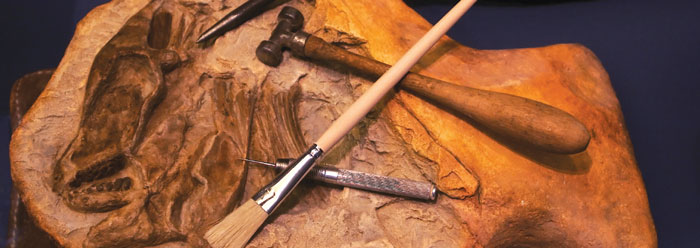Lagerstätten is a word creationists should be familiar with. German for "place, of storage [or] resting place" it refers to a sedimentary deposit extraordinarily rich in the diversity or quality of preservation of its fossils. Paleontologists distinguish two kinds. Concentration lagerstätten are deposits with a peculiar abundance of broken-up hard parts, such as a bone bed. These are interesting, but it is the second variety--called conservation lagerstätten--that we would like to focus on. These include some of the world's most extraordinary fossil deposits, and it is the exceptional quality of preservation of the fossilized organisms, especially their soft parts, that sets them apart.
Workers at fish markets are in the best position to appreciate the significance of lagerstätten. Without salt or refrigeration, decay sets in very quickly on a dead fish. Modern varieties of the small, herring-like fossilized fish from Wyoming's Green River Formation, for example, rot in a period of days or weeks.1 Yet somehow they got pickled by the billions in this world-famous lagerstätten. Either they were rapidly buried in mud or else they got exposed to some unusual oxygen-deprived and/or saline environment soon after death, in order for these fossil fish to be preserved. Not months, nor years, nor millennia, but days! The following are a few other favorite examples.
Preserved in northeast Brazil's Santana Formation are not just the bones of fossil fish, but the mummified remains of gills, muscles, and stomachs.2 Gills are normally infested with bacteria 4-5 hours after a fish's death. "What is clear," reports D. M. Martill, "…is that the phosphatization [fossilization] took place moments after the fish had died and was completed within only a few (probably less than 5) hours." In this case, "instantaneous fossilization" is suspected by Martill to have been the very cause of death!
Crinoids, which are marine animals of the echinoderm or starfish family, comprise famous lagerstätten in both England and the United States. In the walls of New York state's Niagara Gorge (downriver from the Falls) are found whole crinoids that were "buried to death" in lime muds.3
What makes experts Taylor and Brett (1996) so confident? Crinoids, or "sea lilies," are composed of hard plates held together by extremely delicate soft tissue. Ordinarily, death of the organism results in quick disintegration of its plates; but here, whole organisms are preserved. Rapid burial in mud is required.
Are lagerstätten anomalies of the fossil record, or are they telling us something that is basic to its very character? They are certainly more common than what most geologists would have thought possible only a few decades ago. Flood geologists from former generations might have explained it by going back to Genesis.
Footnotes
- Whitmore, J.H., Experimental fish taphonomy with a comparison to fossil fishes, Ph.D. dissertation, Loma Linda University, Loma Linda, CA, 2003.
- Martill, D.M., 1989, The Medusa effect: instantaneous fossilization: Geology Today 5(6): 201-205.
- Taylor, W.L. & Brett, C.E., 1996, Taphonomy and paleoecology of echinoderm lagerstätten from the Silurian (Wenlockian) Rochester Shale: Palaios 11:118-140.
*William A. Hoesch, M.S. geology, is Research Assistant in Geology.
Cite this article: Hoesch, W. 2007. Lagerstatten! Acts & Facts. 36 (8): 14.

















